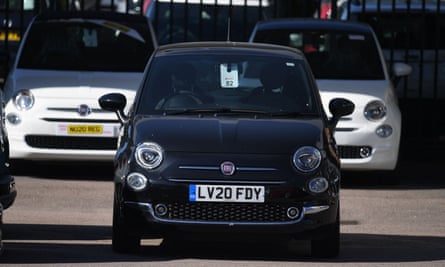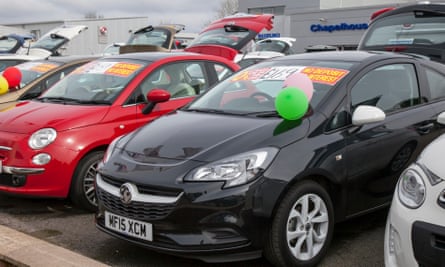
Britain’s car buyers are a nation of borrowers: more than four in every five new cars bought by individuals in 2022 was paid for with borrowed money.
For more than a decade that borrowing, on attractive terms thanks to ultra-low interest rates, opened up the car market to people without much in the way of savings – allowing the Mondeo Man to upgrade to a Mercedes-Benz C-Class.
Soaring interest rates are changing the calculation for potential buyers. The Bank of England has raised its main interest rate 13 times from its all-time low in late 2021 to 5% in June and another hike is expected next month. The average annual rate paid by new car borrowers has doubled in the same period, to 8.4% in June, according to AutoTrader, an online car marketplace.
The number of cars bought on finance fell by 10% in May compared with the same month in 2022, according to the Finance and Leasing Association (FLA), a lobby group. A total of £3.3bn was lent for 179,000 new and used purchases.
Adrian Dally, the FLA director of motor finance, said the decline in new car finance was “monetary policy in action”.
“The intention of monetary policy is to make lending more expensive, and reduce the amount of lending,” Dally said. “Fewer people will qualify for motor finance, and those who do will be paying a higher interest rate.”
The key innovation in UK car finance over the past decade has been the personal contract purchase (PCP), a kind of hybrid of a loan and a rental. The borrower does not own the car until the end of the term – often about three years – when they have the option of paying for the rest of the car with a “balloon” payment, handing it back, or entering another PCP deal.
During the era of unprecedented low interest rates British drivers upgraded their cars to newer models with dizzying frequency at the end of each contract period. The interest rate rise could herald a pause in that trend.
Fewer people will qualify for motor finance, and those who do will be paying a higher interest rateAdrian Dally, FLA
Car payments can take up a significant chunk of monthly household budgets. AutoTrader’s data suggests the average payment has risen to £259 – although that was an increase of only £8 a month from a year earlier.
Yet it comes after several years of increases. Analysis of pricing for five models in November by Whatcar showed that monthly PCP payments had risen by an average of 23% over three years, driven by shortages and rising rates. The cost of a Ford Puma had risen from £257 a month three years ago to £315.
 View image in fullscreenSome car buyers are trading down to less expensive models, the FLA’s Adrian Dally said. Photograph: Daniel Leal/AFP/Getty Images
View image in fullscreenSome car buyers are trading down to less expensive models, the FLA’s Adrian Dally said. Photograph: Daniel Leal/AFP/Getty Images
Dally said the recent flatlining of the UK economy and the cost of living squeeze had led to more people trading down to less expensive models. Others have used savings built up during coronavirus pandemic lockdowns to pay the balloon payment to own the car – which can be half or more of the sticker value of a new car costing tens of thousands of pounds – and avoid further borrowing as interest rates rise. And “there will be more people handing those cars back”, he said.
An £8 monthly hike may be manageable, but it comes at a time when households are being squeezed on all sides by the cost of living crisis, with mortgage or rental payments eating up an increasing slice of household incomes. For those unlucky enough to be coming to the end of a fixed-rate mortgage term, the idea of spending £260 a month on a Ford Puma may gradually become less of a priority – particularly if it is a second car.
Economists expect a slowing UK economy growth to feed through to lower demand for new and used cars (although the latter tends to be a bit more resilient). Gabriella Dickens, an economist at Pantheon Macroeconomics, a consultancy, said she expected UK new car sales to remain between 10% and 15% lower than the average for the five years before the Covid-19 pandemic upended the market.
skip past newsletter promotion
Sign up to Business Today
Free daily newsletter
Get set for the working day – we’ll point you to all the business news and analysis you need every morning
Enter your email address Enter your email address Sign upPrivacy Notice: Newsletters may contain info about charities, online ads, and content funded by outside parties. For more information see our Privacy Policy. We use Google reCaptcha to protect our website and the Google Privacy Policy and Terms of Service apply.
after newsletter promotion
The actual impact is pretty limited on a monthly payment basisIan Plummer, AutoTrader
However, she acknowledged there is a “weird situation” in the car market because many buyers have been queueing for months, waiting for cars to become available during persistent shortages of parts – most notably computer chips. That has also fed through to strong demand for used cars.
The chief executive of a car dealership chain said their company was experiencing strong demand, but a lower proportion of buyers were borrowing money to fund new purchases. That was backed up by AutoTrader data, which showed that 77% of purchases in the first three months of 2023 used finance, down from 92% in 2021 and 84% in 2022.
In 2022, members of the FLA lent £51bn to finance new car purchases. The group’s members range from big banks such as Barclays and Black Horse, owned by Lloyds Banking Group’s car finance arm, to the “captive” finance businesses owned by car companies such Ford, Mercedes-Benz and Stellantis.
 View image in fullscreenSecondhand cars have been in demand as the costs of buying a new model rise. Photograph: ZarkePix/Alamy
View image in fullscreenSecondhand cars have been in demand as the costs of buying a new model rise. Photograph: ZarkePix/Alamy
Yet while the car finance market is large, it does not work in quite the same way as the much bigger mortgage sector: monthly payments do not increase in line with base rates. For drivers who are not well served by public transport options, that increase will be worth it when balanced against being unable to get to work or go to the shops.
“The actual impact is pretty limited on a monthly payment basis,” the AutoTrader commercial director, Ian Plummer, said. “For most people it is absorbable.”
Plummer added that pricing data suggested there is still demand for new cars, even if there will probably be an increase in cases of people unable to make payments.
A 5% bank rate has not been seen in the UK since April 2008, before the Bank of England slashed interest rates to try to revive the economy amid the global financial crisis. However, Plummer noted: “That was the kind of level that we were at in the 90s and the noughties”, when car finance began its boom.
“It could put pressure on demand, but supply remains low,” said Mike Allen, the head of research at Zeus Capital, an investment bank. “We don’t see a crash, but we see a bit of pressure.”
“The people that hold the risk are the finance houses,” said Plummer. “If they get that wrong they’re in trouble,” he added, although for now they seem to have enough financial resilience to weather the interest rate rises
